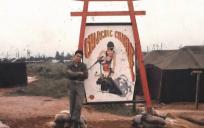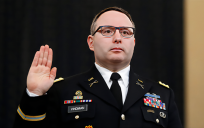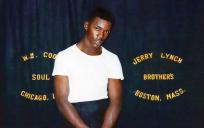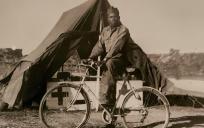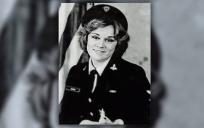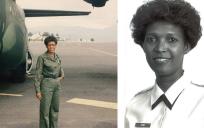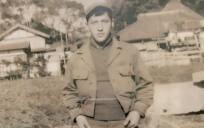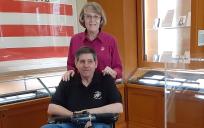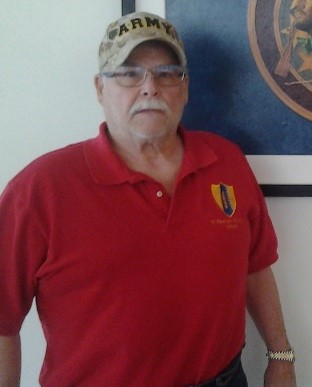
Record date:
Richard Guerine Transcript .pdf
Richard Guerine, Sergeant
Armed with a passion for racing cars and a BA, Richard Guerine enlisted in the US Army in January 1967. With his steeliness and intelligence, it should be no surprise that Guerine was awarded a Silver Star during the Vietnam War. Fellow “tanker”, Major (Retired) Steven Fixler conducts this conversation where everything from tanks, Flechettes to warming C-Rations on high explosives was discussed.
Richard was born in 1944 when his father was serving during World War II. He largely grew up in the Western suburbs of Chicago, where his father was the town lawyer in Melrose Park. After his graduation from Parson College in Fairfield, Iowa, he enlisted in the US Army.
Guerine did basic training at Fort Campbell. He was sent to Fort Knox, Kentucky, for Armor Officer Candidate School for Armor where he learned to drive, shoot, load tanks, and read maps, but decided that being an officer was not for him. He then spent the next nine months running a motor pool as part of a battalion maintenance unit at Fort Knox. After that, Guerine arrived at Saigon International Airport on April 3, 1968, ‘in time’ for the May Offensive. Initially, Guerine was part of the ‘Quarter Cav’ [Alpha Troop, 1st Squadron, 4th Cavalry Regiment, 1st Infantry], based at Phu Loi, where he served as an armorer, repairing small arms weapons. Shortly after, he volunteered for a platoon in the field and became a loader of an M48A3 tank though foot patrol was required too.
He named his tank Abattoir meaning slaughterhouse in French, a language which most Vietnamese understood. He found the M48A3 tank easy to maneuver in diverse environments, be it soft ground, rubber plantations, or roads. Only rice paddies during the dry season were tough on the tanker’s back due to up and downs caused by the dikes. This tank had fewer pounds per square inch than the heel of a 175-pound man. He also did Q [Quarterly] service where the diesel engine and transmission were pulled out and cleaned back at base camp, Quần Lợi.
Guerine applied his mechanical knowledge to make weaponry more effective. For example, the “Ma Deuce”, M2 .50 caliber machine gun was normally on a tripod attached to the cupola of the tank, the small turret which is on top of the larger one. But he cut it down from the tripod and put it inside the turret. Instead, he welded a more powerful gun, on top. This also involved re-wiring the tanks main fire control switches so that anyone could fire the main gun or coax machine gun from the tank commander’s position rather than require a loader to run over to the gunner’s position. Similarly, he polished the inside bolt and C-Channel of the Ma Deuce with metal files and stones, stretched out its spring, and re-worked the pin so that the gun could shoot more rounds per minute.
There were three-line platoons in Alpha Troop. Each one was usually comprised of three tanks and seven ACAVs [armored cavalry assault vehicle] or an M 113. There were usually three people per vehicle. One had to be flexible and Guerine recalls being abruptly commanded to drive an ACAV in spite of no prior experience.
Guerine describes missions such as sweeps, where the armored vehicles would drive through areas of high grass to clear it of explosives or thunder runs where the tanks move at top speed down the highway with no lights on to confuse the enemy. Tanks also provided security to engineering units who were doing “jungle busting,” taking down trees. They also transported food and ammunition to firebases or provided security for other vehicles.
The tankers could be in the field for four months at a time. They would hold a defensive position, with a 360-degree perimeter, aimed to repel attacks from any direction. Supplies, such as fuel, were brought to them by helicopters. When at a firebase, they would put a chain link fence around the perimeter which “caught” the enemy’s RPGs. Situational awareness was also key. Guerine demonstrated that smoking should be prohibited because, even a small flame from a cigarette, can be seen from a distance.
In the late fall of 1968, Guerine was near Lộc Ninh, at the Cambodian border, working with the 11th Armored Cavalry Regiment. He took the AVLB [Armored Vehicle Launched Bridge] to drop a replacement bridge. Suddenly his friend pointed out that there were enemy rounds hitting the ground on both sides of the tank. Guerine immediately got on the radio and commanded everyone to get in position to move out and drive thirty-five miles an hour. He asked the 11th Armored Cav to use their radio frequency to communicate with his own platoon, but their radio got blown out. Guerine was thus in charge of commanding orders on the way back. NVA [North Vietnamese Army] soldiers were right behind the telephone poles and trees next to the road, yet thanks to his leadership, everyone got out and no one was hurt. Upon return to Quần Lợi, Guerine learned that his tank was hit by an RPG. Soldiers in the vehicle behind reported that the fireball was so big, that they thought his tank went up in flames. An officer from the Tactical Operation Center thanked Guerine for saving their vehicles and awarded him a Silver Star.
When acting as a platoon sergeant no one got hurt -- except himself! In November 1968, he was in an operation with 11th Armored Cav as well as 1st Cavalry Division, near the Quần Lợi Cam Rubber plantations. The Army was restricted from firing large guns due to the charge to the US government for destroying rubber trees. Once there were some NVA soldiers about 100 meters in front of their ACAV. His friend, Terry, a recent arrival, disobeyed and fired the M79. According to Guerine, the grenade then hit a tree and then bounced off. As a result, he woke up with glass fragments in his eyes. He was ultimately medevac-ed by helicopters to a hospital in Long Binh, where he received surgery. He regained his vision, but a big chunk of glass remained behind his optic nerve. In April 1969, Guerine finished his tour of Vietnam and coming full circle, ran the motor pool in Fort Knox until his discharge in December.
As a civilian, Guerine directed his intelligence to a variety of studies and professions. Yet, racing, friendship, and activity in veteran associations remained a constant to him. Guerine shares his reflections such as the camaraderie he experienced regardless of race or ethnicity or his respect for all enemy soldiers. While the endless rain of the monsoon season or huge insects were not pleasant, he found Vietnam gorgeous and enjoyed going into the towns to buy items or eat at small restaurants. He is proud that he was able to use his ability effectively and expresses a wish to visit Vietnam again.
